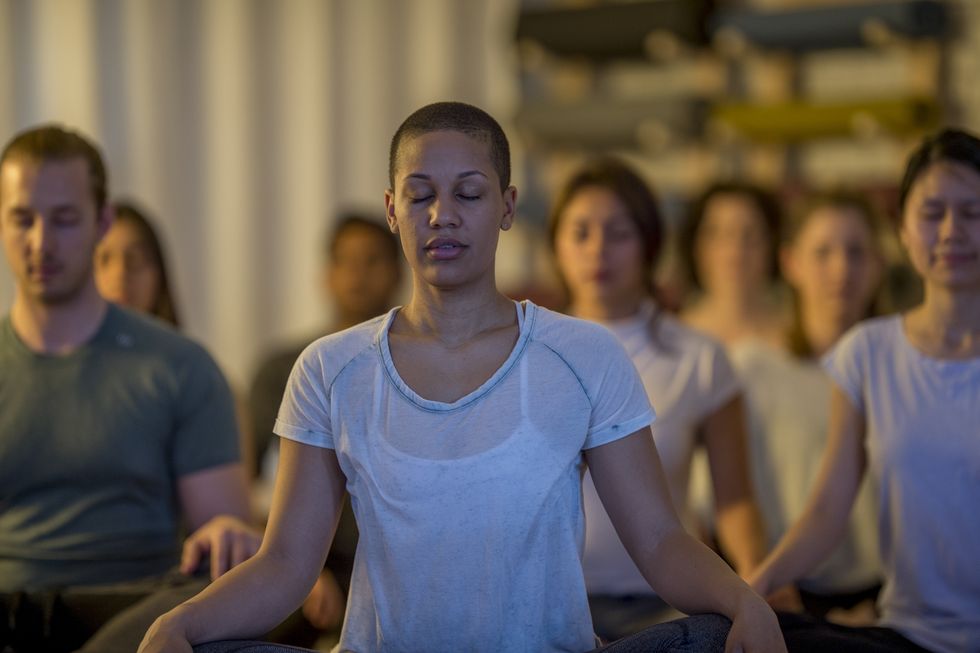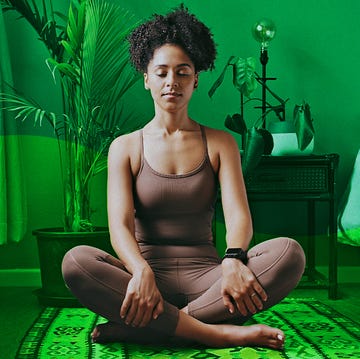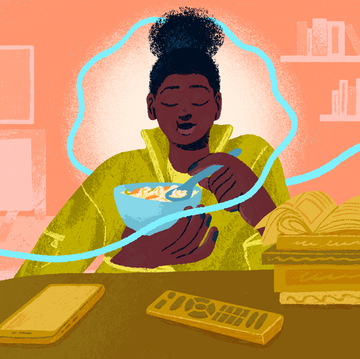Caring for our mental health is more essential than ever before. The way we treat our bodies, how and with whom we spend our time, and what thoughts take center stage in our minds are vital. In the monthly Shondaland series A Path to Well-Being, we’re sharing science and strategies to help you better understand and manage your well-being.
For many people, the mind can feel like a dark, scary forest. You don’t want to go in there — and certainly not alone. Who knows what kind of creepiness is lurking inside? The intimidating nature of our internal world is one reason we love distraction. We pick up our phone during idle moments. We watch TV while we eat. We flip through magazines in the doctor’s waiting room. Being with our thoughts can just be too uncomfortable.
Psychological studies confirm this near-universal tendency. Researchers have repeatedly found that people overwhelmingly don’t like being alone and thinking with nothing else to do. In one study, a majority of male participants and a quarter of female participants opted to give themselves an unpleasant electric shock rather than sit quietly with their own thoughts for 15 minutes — even though moments earlier they’d said they’d pay $5 to avoid being shocked.
An aversion to the mental landscape can be particularly challenging for those who want to reap the benefits of meditation. Studies show that cultivating mindfulness can ease stress, improve sleep, lift mood, reduce inflammation, enhance immune function, increase focus, and lower blood pressure in people with hypertension. However, trying to clear your schedule to sit down to meditate can lead many to a mind flooded with distracting thoughts and ruminations.
“Just because meditation is simple doesn’t mean it’s easy,” says Sebene Selassie, a meditation teacher and author of You Belong. “What we’re actually doing is untraining our patterns, thought loops, or particular ways of thinking that are the reason that brought us to meditation in the first place.”
Meditation and mindfulness help us disengage from familiar thought patterns, most of which we’ve absorbed from our cultural conditioning, according to Selassie. The ideas that we need to look and act a certain way or achieve something in particular are learned patterns that we’ve internalized and run on repeat in our minds.
Ultimately, meditation is an opportunity to become aware of these patterns and offers an opportunity to develop new ways of thinking. “We don’t need to believe everything our minds tell us,” Selassie says, “and that’s what meditation and mindfulness help us to train to do.”
Jon Kabat-Zinn, who developed the popular Mindfulness-Based Stress Reduction program offered at medical centers around the world, describes mindfulness as “awareness that arises through paying attention, on purpose, in the present moment, nonjudgmentally.” It’s this awareness that allows us to be more present in our lives as well as reap those aforementioned physical and mental health benefits.
If the thought of being with your thoughts sounds about as appealing as stepping into a spooky woodland seemingly ripped straight out of a horror movie, here are methods for tapping into the power of mindfulness.
Start small
Three minutes of practice is a great place to start, Selassie advises. “People think they should [meditate] for 20 minutes every morning,” she says, “so if they miss a day or can’t do it for the full 20 minutes, they give up. But make that 20 minutes comparable to 20 minutes of jogging. If [you’ve] never jogged before, that’s a lot.”
The basic practice involves assuming a comfortable posture, either seated in a chair, on a cushion, or lying down, and choosing an object of focus, typically the breath. Feel the sensations of the breath moving in and out. It can help to place a hand on the abdomen or chest to connect to this physical feeling.
When you notice you’ve become distracted — such as thinking about what you have to do today or replaying a conversation — and are no longer tuned in to the feeling of the breath, gently return to your focus. If this happens over and over, no problem. “That’s not a roadblock to the practice,” says meditation teacher and Real Happiness author Sharon Salzberg. “That is the practice.”
Seek support
Meditation practice is a skill, just like taking up a new sport or learning to play an instrument, so look for a teacher or program to get started, Selassie suggests. “If we’re completely new to an instrument or a task — something that doesn’t come naturally to us because we’re so new to it — we would seek out instruction, guidance, support, and maybe accountability and community,” she says. “Being part of a group or a challenge, actually showing up in person, or doing it with a buddy is really helpful.”
Do a quick web search. There are dozens of free meditation challenges that invite 21 or 30 days of consecutive practice. A number of meditation apps also offer sprint-type challenges and guided practices for beginners. Overwhelmed? Try Insight Timer, which offers tens of thousands of free meditations of various lengths and styles. Following a guided practice can be helpful to ease restlessness and develop focus.
Look for mindful moments
Salzberg and Selassie both note that the point of practicing mindfulness meditation is not to become a great meditator but to experience more presence and ease in everyday life. As we learn to let go of distracting thoughts and feelings during our meditation practice, we can more easily let go of problematic emotions and sensations when they arise moment to moment in our lives.
Meditation isn’t just something to check off your to-do list, Selassie emphasizes. It’s a tool for cultivating the skill of mindfulness and “bringing this thing that we’re training into our daily lives.” She suggests using everyday habits as reminders to be mindful. Every time you flick on a light switch or turn a doorknob can be a cue to pay attention: Where am I? Where is my mind? Drinking your morning tea or coffee can be a mindful experience as you smell the brew, feel the warmth of the cup in your hands, and experience the temperature and flavor of each sip.
“Give yourself a space daily or multiple times a week that you can start to bring this formal practice into your day-to-day life,” Selassie advises, “and also notice when it occurs. Spontaneously, it will start to happen more and more. They say awakening is an accident — and meditation makes you accident prone.”
Sandy Cohen is a writer, health and wellness coach, and host of the Inner Peace to Go podcast. Follow her on Instagram @YouKnowSandy.
Get Shondaland directly in your inbox: SUBSCRIBE TODAY

















